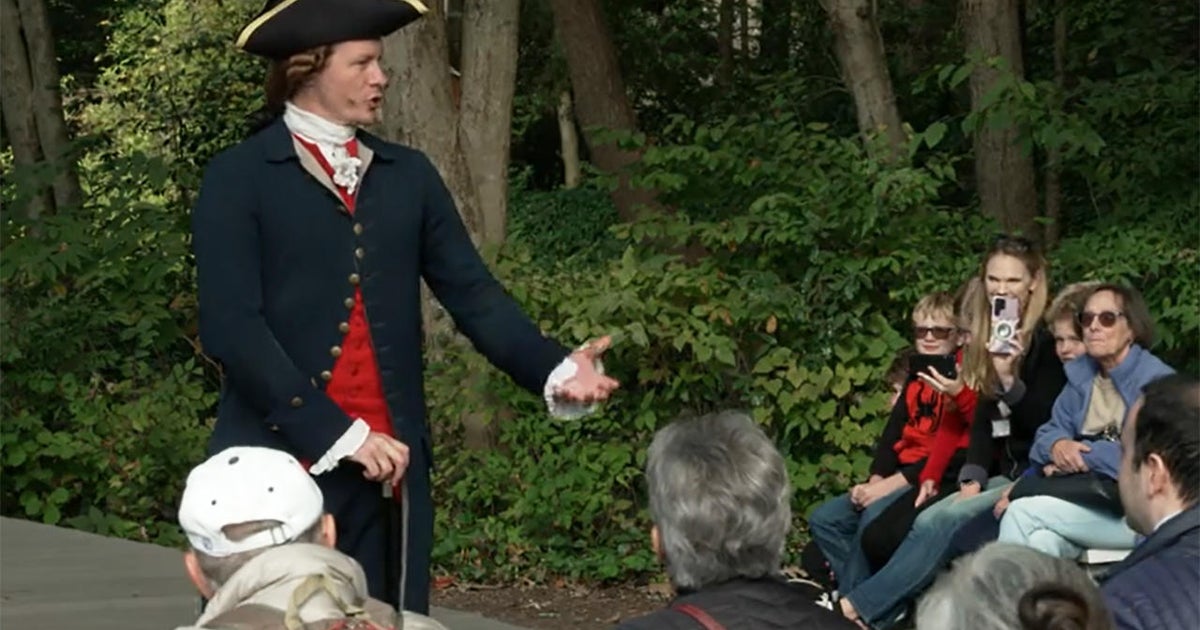CBS News
Inside “Scattergood,” the oldest structure on the CIA’s campus

When buying a house on 30 wooded acres in northern Virginia, the last thing you might expect to get is a nosy neighbor.
But after Margaret Scattergood and Florence Thorne moved into their new home in 1933, they got more than they bargained for – an entire campus full of spies.
“We tried to make sure that we didn’t impede or encroach on their life too much,” said CIA Public Affairs Officer Janelle Neises, who has served as the house’s historian. “We tried to consider them sort of a part of our organization while letting them live their lives very separately at the same time.”
“In fact, a lot of our officers became friends with especially Margaret towards the end of her life,” she said. “They would come out and see if she needed help with yard work, or if she needed help with getting her groceries.”
The women lived in the house for more than a decade, hosting family members and holding events like weddings, dinners and birthday parties. They called their property, which was surrounded by rolling vegetable gardens and lush orchards, “The Calvert Estate.”
Then, in the late 1940s, the U.S. government came knocking.
HUM Images/Universal Images Group via Getty Images
The Federal Highway Administration began buying up the land – at the time mostly farmland – in McLean, Virginia. Scattergood and Thorne struck a deal with the government, selling the house and grounds for $55,000 – but demanding they be allowed to live out their lives on the property.
At the time, the Central Intelligence Agency’s (CIA) headquarters were in downtown Washington, DC, in a section of town called Foggy Bottom. The agency had taken over the buildings of its predecessor organization, the Office of Strategic Services (OSS), which was set up in 1942, during World War II. Soon after OSS’s dismantlement, the CIA was established in 1947.
“It became very obvious in the 1950s that we needed more space,” Neises said. “Director [Allen] Dulles really wanted us to be in a safe environment…He found this land and thought it was the perfect place for the CIA’s new headquarters building.”
Neises said the area was appealing because of the relative safety it would afford CIA employees – set back in a wooded area, with the Potomac River on one side – while still in reasonable proximity to Washington, DC, where officials would have to go to brief policymakers and the president.
The agency began moving its employees into the Headquarters Building in 1961.
“And so, as crazy as it sounds, we had this family, these two women, and sometimes their family members, living on our secure compound,” Neises said.
“I’m not aware of any other intelligence community partner – the FBI or the State Department or [National Security Agency] that has a house where people actually lived on their property while they were doing their missions,” she said. “So it’s something that’s very unique.”
Nick Blanchet, Scattergood’s great-grand-nephew, was one such family member. For a few years in his 30s, he lived with his “Aunt Marge” on the property.
“I really enjoyed tea time, which was sherry time for Aunt Marge,” he said, laughing. “She liked to have her glass of sherry.”
Blanchet recalled some of the intimate family moments – including his wedding in 1983 – on the property grounds, all with CIA expanding its campus right next door.
“It was such a beautiful place,” he said. “It was completely private, but I think the CIA could tell what was going on,” he added, laughing.
Asked why he thought that was, he shot back, “Because they’re the CIA!”
Neises denies officers ever spied on the women.
“We have officers who still remember Margaret and talk of her,” she said, “It was just friendships.”
A committed Quaker and fluent French speaker, Scattergood traveled to France to help refugees during World War I. After the war ended, she drove a truck full of rabbits and chickens to refugee areas. In her youth, she drove across the U.S. in a Ford Model T, with four tires strapped across it.
“I asked her about driving across [the] country, I asked her why there’s so many tires,” Blanchet said, “And she said, ‘Well, there weren’t any garages. If you got a flat, you had to fix it yourself!'”
“They were incredible women, pioneers in the labor movement,” Neises said. “Both of them went to college in the late 1800s, which was kind of a big deal for the time.”
After Scattergood met Thorne, in 1926, the two fought for workers’ rights at the American Federation of Labor (AFL).
“Florence is really interesting in the fact that the work that she did at the AFL actually led to legislation for Social Security, workers’ compensation, and really made a difference when it came to child labor laws,” Neises said. “These were two women who sought out not just adventure, but making the world better.”
After Thorne passed away in 1973, at the age of 95, family lore says Scattergood may have opened her doors to political refugees known as Sandinistas from Nicaragua, where, at the time, CIA was covertly backing an opposing rebel group – the Contras.
“There are rumors that Sandinistas showed up at the CIA,” Neises said. “We don’t have any records of them actually coming onto the compound.”
“[M]aybe they tried, but there’s nothing in our records that say they actually came here and met with Margaret,” she continued, adding, “…but it wouldn’t surprise me if Margaret was helping people that she thought needed help.”
While Scattergood, a pacifist, held views that were in tension with some of the CIA’s activities at the time, her family and CIA officials say her relationship with the agency was not contentious.
“[I]n fact, Director [William] Casey invited Margaret to celebrate her 90th birthday up in his dining room,” Neises said.
When Scattergood passed away in 1986, at age 92, the CIA officially took over the house and its grounds.
For a time, CIA Deputy Director David Cohen said: “It went to the dogs.”
“It became the location for our K-9 unit,” he explained. “They had an obstacle course outside. And then, in the house, we would plant fake explosives for the dogs to identify and find.”
“We rely on these dogs here, on the compound, but also overseas, to keep our officers safe,” he said.
“[T]he floors were just destroyed by the dogs,” Neises said. “[Y]ou can imagine all of the scratches that they had, running up the beautiful set of stairs.”
After about a decade of hosting canine inhabitants, the house fell into disrepair. It was near demolition, until “Mike M.”, a senior officer, and then CIA’s director of support, intervened.
“I think Mike was aware of the history of this beautiful house and saw that it could be a very useful place for the agency to have…as a place for people to get away a little bit,” Cohen said.
After an archeological study was completed to ensure it was structurally sound, the house was renovated from top to bottom. Upstairs bedrooms now look more like boardrooms; the family kitchen is now outfitted for professionals.
But some things stayed original, including the grand central banister, the wrought-iron windows, and a secret little spot in the basement where a part of the original foundation is preserved. The house has been placed on the National Register of Historic Places as a historical landmark, according to Neises.
Only one door in the house stays locked. Officials said behind it is a functioning office for onsite support staff – denying it conceals a sprawling Situation Room or other secret CIA artifacts.
In 2004, the house was fully reopened, and renamed: “The Scattergood-Thorne Conferencing Center.” The first-ever event held on its grounds was a ribbon-cutting with the then-Director George Tenet and about 50 guests.
The second was Mike M.’s retirement ceremony.
In 2005, it convened every living CIA director for a “farewell ceremony” for the title of “Director of Central Intelligence.” The director’s title was changed to “Director of the Central Intelligence Agency” after the Office of the Director of National Intelligence was stood up in the aftermath of the Sept. 11 attacks.
“You had everyone from President George Bush ’41 to the current director at the time,” Neises said. “Before they came to the house, they actually met on the seventh floor, which is where the director’s office is… and then took a shuttle bus to the house.”
The property served a key role during the COVID-19 pandemic, when it was securely outfitted for use as an office by then-Deputy Director Vaughn Bishop.
“It was decided that to keep our top two, our director and our deputy and their staffs [safe], that we needed to split them up because… their offices are connected, basically,” Neises explained. “And to make it safer, we had Vaughn move out to the Scattergood house.”
“At one point, they baked cookies in the kitchen,” she said. “You know, you can’t do that on the seventh floor, you can’t just walk into a kitchen and put some cookies in the oven.”
The house also served as a dedicated space for the Biden Presidential Transition Team.
“[Y]ou had members of the outgoing team and the incoming team that also needed to come out for meetings and briefings,” Neises said. “And so having this house kept all of those people from coming in and out of the main headquarters building, which is where a large part of our workforce is, and so that kept them safer.”
Today the property is used for strategic meetings, including a Senior Leadership Seminar led by CIA Director William Burns, as well as an annual meeting with the agency’s chief of stations from all around the world.
“Scattergood lends itself to being a place where conversations happen because there are no phones, there are no computers, there’s no distractions. And so all you have is that human interaction and talking,” Neises said. “[W]hen you add into the mix the variety of the types of people we have here at Scattergood…you’re going to get some of the most interesting and possibly important conversations that happen in this country.”
“There have been some very important dinners and other events that have been hosted here for foreign visitors,” Cohen added, though he declined to name or confirm any specific guests.
While most of its visitors and events today remain a secret, the house stands as a reminder of the trailblazing women whose names and legacies it still bears.
“I think Margaret and Florence would appreciate the fact that the CIA took such care of the house,” Neises said. “We were able to bring it back to its former glory.”
“And then as far as what happens inside of the house, I would hope that they would appreciate the human connections that we try to make here,” she added, “That the people coming into this home love this country…and that everyone here has the intentions of making the world safer.”
CBS News
Here Comes the Sun: Jack Antonoff and more

Watch CBS News
Be the first to know
Get browser notifications for breaking news, live events, and exclusive reporting.
CBS News
Capturing Moriah Wilson’s Killer – CBS News

Watch CBS News
Be the first to know
Get browser notifications for breaking news, live events, and exclusive reporting.
CBS News
How to watch the Minnesota Vikings vs. Chicago Bears NFL game today: Livestream options, more

Getty Images
The Minnesota Vikings will take on the Chicago Bears today. The Vikings are currently 8-2, an impressive run so far this season, and will be looking to add a fourth win to their current streak after last Sunday’s 23-13 win against the Tennessee Titans. The Bears, on the other hand, are entering this game on the heels of a four-game losing streak after a tough 20-19 loss against the Green Bay Packers last Sunday.
Here’s how and when you can watch the Vikings vs. Bears game today, whether or not you have cable.
How and when to watch the Minnesota Vikings vs. Chicago Bears
The Vikings vs. Bears game will be played on Sunday, November 24, 2024 at 1:00 p.m. ET (11:00 a.m. PT). The game will air on Fox and stream on Fubo and the platforms featured below.
How and when to watch the Minnesota Vikings vs. Chicago Bears game without cable
You can watch this week’s NFL game on Fox via several streaming services. All you need is an internet connection and one of the top options outlined below.
Fubo offers you an easy, user-friendly way to watch NFL games on CBS, Fox, NBC, ABC, ESPN, and NFL Network, plus NCAA football channels. The Pro tier includes 200+ channels and unlimited DVR, while the Elite with Sports Plus tier adds NFL RedZone and 4K resolution. New subscribers get a seven-day free trial and all plans allow streaming on up to 10 screens simultaneously.
You can watch today’s game with a subscription to Sling’s Orange + Blue tier, which includes ESPN, ABC, NBC, and Fox. The plan offers 46 channels with local NFL games, nationally broadcast games and 50 hours of DVR storage. For complete NFL coverage, add Paramount+ to get CBS games, or upgrade with the Sports Extra add-on for additional sports channels like Golf Channel, NBA TV and NFL RedZone.
Watching NFL games, including Fox broadcasts, is simple with Hulu + Live TV, which includes 90 channels, unlimited DVR storage, and access to NFL preseason games, live regular season games and studio shows. The service includes ESPN+ and Disney+ in the subscription.
Want to watch today’s game live on your smartphone? If so, NFL+ streaming service is the solution you’re looking for. It lets you watch NFL Network and out-of-market games on mobile devices, with an upgrade option to NFL+ Premium that includes NFL RedZone for watching up to eight games simultaneously. Note that NFL+ only works on phones and tablets, not TVs.









